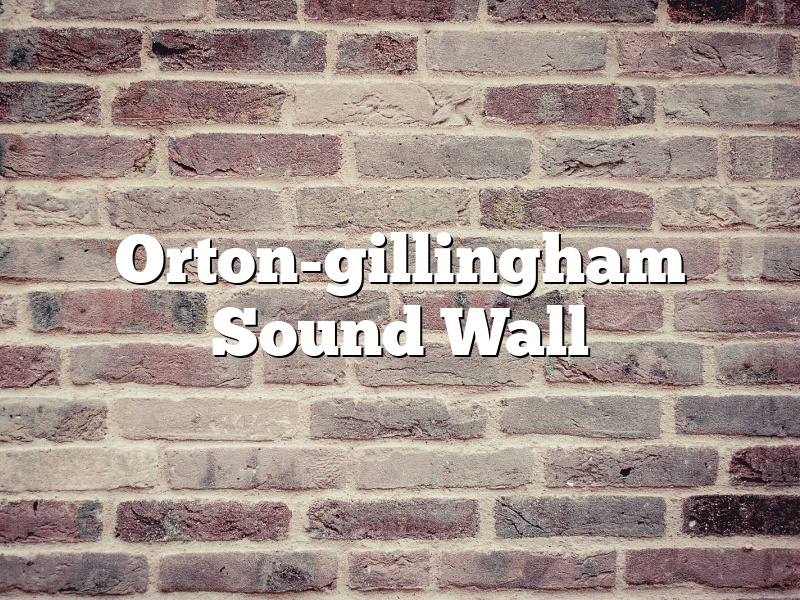The Orton-gillingham Sound Wall is a device that is used to improve the sound quality of a room. It is made up of a series of wooden panels that are placed on the wall of a room. The panels help to absorb sound and reduce echoes. This can help to improve the sound quality of a room for music, speech, or other audio activities.
The Orton-gillingham Sound Wall is available in a variety of different sizes. It can be used in both residential and commercial settings. The panels are made from high-quality wood, and they are designed to last for many years.
If you are looking for a way to improve the sound quality of your room, the Orton-gillingham Sound Wall is a great option. It is easy to install, and it can make a big difference in the sound quality of your space.
Contents
Does Orton-Gillingham use sound walls?
Orton-Gillingham is a reading program that is often used in schools to help students with dyslexia. It is a phonics-based reading program that uses sound walls to help students learn to read.
A sound wall is a visual representation of the phonemes in a word. It is a list of the phonemes in a word, with each phoneme represented by a different color. The sound wall for the word ‘cat’ would look like this:
/k/ – red
/æ/ – green
/t/ – blue
The sound wall can help students to identify the phonemes in a word and to read the word correctly. It can also help students to spell words correctly.
What is a sound wall in reading?
A sound wall is a term used in reading to describe how a reader’s tone of voice affects the meaning of a text. A sound wall can be used to make a text sound more formal or to emphasize certain words or phrases.
How do you introduce a sound wall?
A sound wall is a structure specifically designed to reduce noise levels from either vehicles or aircraft. They are most commonly used near airports, highways, and busy city streets.
There are a few different ways to introduce a sound wall. The most common is by constructing it as part of a new road or highway project. In this case, the wall is often built as part of the right-of-way and is included in the original plans. If a community decides they want a sound wall after a road or highway has been built, it can be more difficult to get approval and funding.
Another way to introduce a sound wall is by retrofitting an existing structure. This is often done when a new development is built near an airport or other busy area. The wall is added to the existing structure, such as a building or fence, to help reduce the noise levels.
There are a few things to consider when designing a sound wall. The most important factor is the height of the wall. The wall should be tall enough to block the noise from the source. It should also be wide enough to cover the entire noise source.
The type of material used for the wall is also important. The wall should be made of a material that will absorb the noise. The most common materials are concrete, brick, and metal.
Finally, the design of the wall is important. The wall should be simple and plain to avoid distracting from the noise it is trying to block.
What grades should have sound walls?
In many communities, it is common to see sound walls lining the interstate or other busy road. While many people may not think much of the walls, they play an important role in mitigating the sound of traffic.
There are a few different grades of sound walls, and each one serves a different purpose. The most common type of sound wall is a concrete wall. These walls are typically used to block out sound from a major roadway or interstate.
Concrete walls are effective at blocking out sound, but they are also very expensive to build. For this reason, they are typically only used in high-traffic areas.
Another type of sound wall is a vinyl-coated steel wall. These walls are less expensive to build than concrete walls, but they are not as effective at blocking out sound.
Finally, there is the sound-absorbing wall. This type of wall is made of materials that absorb sound, such as foam or fiberglass.
Sound-absorbing walls are the least expensive to build, but they are also the least effective at blocking out sound.
So, what grade of sound wall should your community choose?
The answer depends on the level of noise that is being emitted from the road. If the noise is above a certain level, then a concrete or vinyl-coated steel wall is the best option. If the noise is below a certain level, then a sound-absorbing wall is the best option.
It is important to note that the grade of sound wall that is best for your community may vary depending on the location. For example, a sound-absorbing wall may be a better option for a community that is located near a busy airport.
So, what grades should have sound walls?
Concrete walls are best for high-traffic areas, vinyl-coated steel walls are good for moderate-traffic areas, and sound-absorbing walls are best for low-traffic areas.
What order do you teach the sound wall?
The sound wall is an important part of learning to read and speak English. The order in which you teach the sound wall is important so that your students will be able to read and speak English correctly.
The first sound that students learn in the sound wall is the letter A. They learn to say the letter A and to recognize the letter A in words. Next, students learn the letter B. They learn to say the letter B and to recognize the letter B in words. This continues until students learn the letter Z.
After students learn the letters of the alphabet, they learn the sounds that the letters make. They learn to say the sounds and to recognize the sounds in words. This continues until students learn all of the sounds in the English language.
Finally, students learn to put the sounds together to form words. They learn to read and speak words correctly. This continues until students learn all of the words in the English language.
The order in which you teach the sound wall is important so that your students will be able to read and speak English correctly.
Do sight words go on a sound wall?
There is a lot of debate surrounding how to teach reading. Some people believe that teaching children to read through phonics is the best way, while others believe that teaching sight words is the best method. So, the question is, do sight words go on a sound wall?
The answer to this question is a little complicated. It depends on how you define sight words and sound walls. Generally, sight words are words that are learned by sight, without using phonics. They are usually words that are common and appear often in books. Sound walls, on the other hand, are lists of words that are taught through phonics.
So, the answer to the question depends on how you define sight words and sound walls. If you consider sight words to be simply words that are learned by sight, then the answer is no, sight words do not go on a sound wall. However, if you consider sight words to be words that are learned without phonics, then the answer is yes, sight words can go on a sound wall.
There is a lot of debate surrounding how to teach reading. Some people believe that teaching children to read through phonics is the best way, while others believe that teaching sight words is the best method. So, the question is, do sight words go on a sound wall?
The answer to this question is a little complicated. It depends on how you define sight words and sound walls. Generally, sight words are words that are learned by sight, without using phonics. They are usually words that are common and appear often in books. Sound walls, on the other hand, are lists of words that are taught through phonics.
So, the answer to the question depends on how you define sight words and sound walls. If you consider sight words to be simply words that are learned by sight, then the answer is no, sight words do not go on a sound wall. However, if you consider sight words to be words that are learned without phonics, then the answer is yes, sight words can go on a sound wall.
What is the purpose of a sound wall?
A sound wall, also known as a noise barrier, is a structure designed to reduce noise levels from reaching nearby residences and businesses. The most common type of sound wall is an impermeable structure made from concrete, metal, or plastic that is designed to deflect sound waves.
There are a variety of reasons why someone might choose to install a sound wall. In some cases, the wall is erected to mitigate the negative effects of traffic noise on nearby residents. In other cases, the wall may be used to protect a specific area from the noise generated by an industrial or commercial facility.
Sound walls can also be beneficial for wildlife. In some cases, the wall can help to create a quiet zone where animals can live and breed without being disturbed by noise.
There are a number of factors that need to be considered when designing a sound wall. The height, thickness, and materials used in the wall all play a role in the amount of noise that is deflected. Additionally, the location and orientation of the wall can also affect its effectiveness.
Sound walls are often controversial. Some people feel that they are an eyesore, while others believe that they are an important part of mitigating noise pollution. There is no doubt that sound walls can be a valuable tool for mitigating noise, but it is important to consider the pros and cons before installing one.



